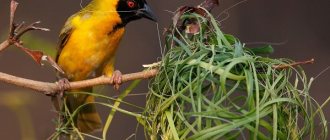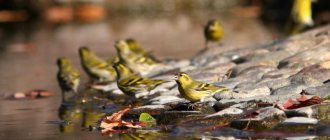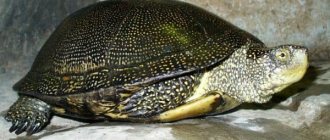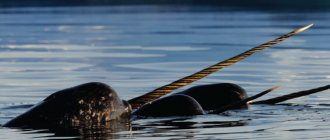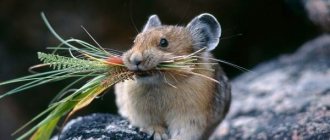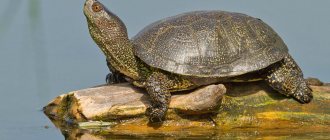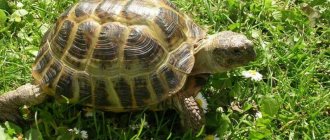Description and features
The main terms that we will need when describing our semi-aquatic inhabitant are carapace and plastron. Carapace refers to the hard covering on a turtle's back. It has an almost round and curved shape, is very durable, it consists of horny tissue, and underneath it is a bone structure. Plastron is the same covering, only on the belly, and flatter.
In the European emyd, the carapace usually looks oval-shaped, slightly convex, with a glossy surface. It, like all turtles, is connected to the plastron by flexible ligaments that hold them together. The protective box is ready, the top and bottom are very strong, the sides are open.
It is not very convenient for them to constantly be in a limited state, but they are used to it, and compensate for this with great mobility of the neck, capable of bending like a periscope in different directions. In young individuals, the upper shield is more round in shape, with a low growth in the form of a “keel” closer to the tail
The tail of emids is quite elongated, usually it is ¾ of the size of the shell, and in the younger generation the tail is even longer relative to the shell. It serves as a “rudder” when swimming.
The front paws have five toes, the hind paws have four, and there are small swimming membranes between them. All fingers are equipped with large claws. Our heroine is usually of average size. The dorsal shield reaches 35 cm. The animal weighs about 1.5 kg.
The color of the carapace can be different, all the colors of the swamp range, from green with a gray tint to brownish-greenish. The habitat dictates the color of the camouflage. For some it may be dark to black. Most likely, the color is related to age and dietary habits.
Yellow streaks and specks are scattered across the entire surface. The scutellum on the belly is much lighter, usually an ocher shade (yellowish) or slightly darker, all speckled with charcoal color. All protruding parts of the body - paws, tail and head with neck - have a dark marsh color with ripples of ocher specks and strokes.
The eyes are the usual amber color for a reptile, although they can be orange and even red. The jaws are strong and smooth, there is no “beak”. The marsh turtle in the photo looks like a small bone chest.
It is compact, the oval “lid” is beautifully painted “antique”. If, moreover, the emida hid in her “house”, neither her paws nor her head are visible - she does not look like a living creature, more like an ancient box or a large stone.
Origin of the species and description
Photo: Red-eared turtle
Fossils indicate that turtles first appeared on earth about 200 million years ago, during the Upper Triassic period. The first known turtle was Proganochelys quenstedli. It had a fully developed shell, skull-like skull and beak. But, Proganochelys had several primitive features that modern turtles do not have.
By the mid-Jurassic period, turtles had split into two main groups: those with arched necks (pleurodire) and those with side necks (cryptodires). Modern side-necked turtles are found only in the southern hemisphere and move their heads to the side under the shell. Arch-neck turtles retract their heads in an S shape. Scutemy was one of the first arch-neck turtles.
Video: Red-eared slider
The red-eared or yellow-bellied turtle (Trachemys scripta) is a freshwater turtle belonging to the family Emydidae. It gets its name from the small red stripe around its ears and its ability to quickly glide off rocks and logs into the water. This species was previously known as Trost's turtle after American herpetologist Gerard Trost. Trachemys scripta troostii is now the scientific name of another subspecies, the Cumberland turtle.
The redfish belongs to the order Testudines, which contains about 250 species.
The species Trachemys scripta itself contains three subspecies:
- Ts elegans (red-eared);
- T.s. Scripta (yellow-bellied);
- Ts troostii (Cumberland).
The first known literary mention of redears dates back to 1553. When P. Cieza de Leone described them in the book “Chronicles of Peru”.
Kinds
Turtles are relict animals that have lived on Earth for a very long time. It is clear that they have many family ties. A large family tree. To find out who our heroine’s relatives are, we need to dig down to at least the 3rd generation - “grandparents”. In other words, start with the family.
American freshwater turtles, to which our beauty belongs, were previously simply called freshwater turtles. So far, Asian freshwater animals have not been separated from the “family” due to some differences: their musk glands have ducts in some marginal plates (in the third and seventh pairs), as well as along the height of the 12th pair of marginal scutes.
Representatives of this subfamily are found in a large size range - from 10 to 80 cm. There are 20 genera, which include 72 species. The most numerous of them are aquatic, batagur, articulated. In the former USSR, the subfamily was represented by Caspian turtles living in Turkmenistan, Transcaucasia and Dagestan.
The American turtle family Emydidae, which remained after the division, included 11 genera, including 51 species. The largest by number of species are humpback, ornate, box, trachemus and Emys marsh turtles. They are small in size, some individuals have bright and unusual colors. Most of them come from America, but there are individuals living in other parts of the world.
The genus Emys is precisely the Eurasian specimen. This genus is now divided into two species: Emys orbicularis, a European marsh turtle, and Emys trinacris, a Sicilian species described recently, in 2015. So we got closer to our heroine. Emys orbicularis includes 16 subspecies included in five groups. The following varieties are found in Russia:
- Colchis marsh turtle , lives in the Black Sea region and southwestern Transcaucasia, as well as in eastern Turkey. She has a carapace measuring up to 16.5 cm, and a small head;
- Kurinskaya - lives in the Caucasus and on the shores of the Caspian Sea. Carapace approximately 18 cm;
- Iberian - settled in Dagestan, in the Kura River basin.
- The Eastern Mediterranean chose the south of Crimea, the upper shield of the shell is up to 19 cm.
- Nominative species Emys orbicularis orbicularis. In the Russian Federation, the habitat ranges from the western regions through the center to eastern Asia, the carapace is about 23 cm or more.
Types of marsh turtles
is considered a prominent representative of this genus . She is the owner of a smooth carapace, which has a round or oval shape.
Its color can be greenish-yellow or black with a pattern, dotted with various combinations of rays and lines, as well as white or yellow spots. When wet, the shell changes color as it dries, from shiny in the sun to gradually becoming matte.
The turtle's head is pointed and large, and its skin and paws are dark, dotted with spots. The reptiles weigh about one and a half kilograms and reach approximately 35 cm in size. Moreover, the largest individuals live in Russia.
European marsh turtles are divided into 13 subspecies with different habitats. Individuals differ in appearance, size, color and some other parameters.
Pictured is a European marsh turtle
In Russia, where five subspecies of such reptiles are common, black turtles are mainly found, and individuals with a greenish-yellow shell live under the hot sun of Sicily.
The genus of reptiles described includes another species - the American marsh turtle, which has a carapace 25-27 cm long. The main background of the shell is dark olive, and small light spots are clearly visible on it.
Representatives of the fauna of this species have significant similarities with European marsh turtles in appearance and behavior. For a long time, these two species of animals were considered by scientists to be the same type, but a deeper study of genetics and the structure of the internal skeleton led to the identification of significant differences in these reptiles, which gave reason to now consider them separate species of swamp turtles .
Lifestyle and habitat
The marsh turtle lives everywhere in Europe, except in the polar regions, as well as in Central Asia. Very widely represented on the Balkan Peninsula (Albania, Bosnia, Dalmatia) and in Italy. A common inhabitant of water bodies in northwestern Germany.
This species can be found in northern Africa, as well as in the Caucasus Range and closer to the western borders of Russia. Often found in the southern regions and central part of the Russian Federation. In the pre-glacial period, it was widely settled on the site of modern Europe; in some places, relict populations can still be found.
The landscape familiar to it is forests, steppes, foothills. Rarely, but may appear within a city or other settlement. She is able to “climb” into mountains up to 1400 m in height, and the Moroccans have seen even higher - 1700 m in the mountains.
Loves stagnant shallow reservoirs, calm rivers and swamps. It swims very quickly in water, so it easily catches its potential prey. It may not rise to the surface for a long time.
Experiments were carried out that showed that the emida, without visible effort, spent almost two days in a completely closed reservoir with a water temperature of 18º C. However, in nature, it still emerges almost every quarter of an hour to take a breath of air.
On land, the European tortoise is clumsy and crawls slowly. However, she is still more agile than her land relatives. Her energy and activity are more evident during the day. The reptile hunts and also sometimes comes out to bask in the sun, periodically again diving into the pond to cool off.
This behavior is called thermoregulatory support. Moreover, the animal is very careful, trying not to move far from the water. Sensing danger, it hurries to dive into the saving aquatic environment or burrow into the mud. Only at the moment of laying eggs can an emida move almost 500 m away from the water. In Turkmenistan, they were seen 7-8 km from water bodies, but this is rather an exception to the rule.
Regarding intelligence and intelligence, there are observations that these creatures are well trained, cunning and careful. And of course, no more stupid than other relatives. And in captivity they quickly adapt and become literally tame.
Closer to winter, they become numb, hibernating, after hiding in the silt or ground. By the way, sometimes they do this during drought. Usually wintering begins at the end of October, but in warm winters it can begin later, and sometimes is completely canceled.
Pond slider
On the southern coast of Crimea, the North American red-eared turtle began to be recorded more and more often. Outside the Gulf Coast (eastern United States, Mexico, and northern South America), this species is most often kept in captivity. But many owners, unable to cope with caring for their animals, release their pets into nature. As a result, Trachemys scripta becomes an invasive species.
Where else are red-eared turtles found in Russia? Until recently, scientists believed that encounters with representatives of this species were random. However, they are increasingly being recorded in ponds in Moscow and the Moscow region. The climatic zone of the southern European part of the country is quite suitable for Trachemys scripta elegants and other subspecies, which can cause harm to existing ecosystems.
Nutrition
It has already been mentioned that the turtle is very agile in water. Catches worms and insects, frogs and fish, and first bites off the swim bladder of the latter. Then he throws it out, and it remains floating on the water. This way you can understand whether turtles live in a pond or river.
If you see fish bubbles on the surface of the water, you can be sure that there is an emida there. Previously it was believed that she was a night hunter. However, the reptile just rests at night, falling asleep at the bottom of the reservoir. And early in the morning he goes hunting, and does this all day, with the exception of short breaks.
She does not refuse mollusks, crustaceans, dragonflies and mosquito larvae. In the steppes it catches locusts, in the forest - centipedes and beetles. Attacks small vertebrates, small snakes and waterfowl chicks. She does not disdain carrion, eating the corpses of small animals and birds.
So fish is not her main dish. Priority is given to “meat” products. Therefore, fears that marsh turtles are damaging fish ponds by catching all the fish are incorrect. Observations showed that most of the emida's attempts to hunt healthy fish failed, and the prey managed to elude the hunter.
Of course, if our reptile found itself in places with large concentrations of these aquatic inhabitants, then the likelihood of a successful attack increased. In the fauna, the turtle plays an important role as an orderly for its native reservoir, as it destroys carrion, and also as a breeder, since it can selectively catch only weak and sick individuals.
With the caught prey, she goes to the depths and deals with it there. It tears large pieces into pieces using powerful jaws and sharp claws. Plants are not a priority on the menu. She can chew algae and the juicy pulp of other plants, but this is rather an addition to the main “meat” diet.
Lifestyle
European marsh turtles are very active and mobile reptiles. During the day they hunt, swim and bask on rocks or on land in the sun. These reptiles are excellent swimmers and divers. If there is danger or a threat to life, a marsh turtle can jump from a steep cliff directly into the water. Some species are able to dive from a height of 2-3 meters.
When in danger, a marsh turtle can hide at the bottom for quite a long time, or burrow into the mud. But she cannot stay under water all the time. The maximum time a turtle can stay underwater is 2 hours. Usually every 10-15 minutes the reptile comes to the surface to take in air.
In the water, marsh turtles are very nimble. The long tail acts as a “rudder” and helps it change direction sharply. On land they are not as agile as in water, but much faster than land turtles.
Some species can move up to 1 km from the reservoir. They are also capable of climbing mountains to heights of up to 2 thousand meters.
The enemies of reptiles are predatory animals and birds. Foxes, wolves, raccoons, otters, ferrets, eagles and crows destroy turtle nests. They not only destroy eggs, but can also feast on small defenseless turtles.
Reproduction and lifespan
The instinct to procreate comes to them at the age of 5-9 years, which is when turtles mature. The mating season begins immediately after the gradual awakening from hibernation. This does not happen everywhere at the same time, but depends on the climate in the regions. In our temperate latitudes it is April-May.
By that time, the air warms up to +14º C, and the water - to +10º C. The event can take place both in water and on land. If at this moment they are in shallow water, then the backs of the males are visible, which rise above the surface of the reservoir, but the female is not visible, she is completely in the water under them at that time.
The process takes 5-10 minutes. Eggs are usually laid near their native waters. But there are also exceptions. Particularly restless turtles, in order to find a more secluded place for their future offspring, go quite far from home. In warm areas, a female manages to make 3 clutches per season, in cool areas - 1-2.
To lay eggs, the mother digs a hole up to 17 cm deep within 1-2 hours, working with her hind legs. The shape of this depression resembles a jug with a bottom of about 13 cm and a neck of up to 7 cm. She also prepares the place for the hole in advance, carefully clearing a small area of earth with her front paws and head.
The eggs come out gradually, 3-4 eggs approximately every 5 minutes. The number of eggs varies, reaching 19 pieces; they have a hard, white, calcareous shell. They have the shape of an ellipse, measuring from 2.8 * 1.2 to 3.9 * 2.1 cm, and weigh 7-8 g. After all, the female digs a hole and carefully levels the ground above it with her belly, like a bulldozer, masking the laying site.
The incubation period lasts from 60 to 110 days, depending on the climate of the region. Hatched turtles do not immediately rush to the surface. On the contrary, they burrow deeper, overwinter underground and emerge only in the spring. True, there are brave souls who still crawl out and dive into the pond. Then they spend the winter under water.
All babies have a very dark color, closer to black, with only light specks in places. They have a yolk sac on their belly, from which they feed throughout the long winter. Their carapace size is about 2.5 cm, body weight is about 5 g. Turtle nests are constantly destroyed by all predators that are able to reach them.
Swamp turtle eggs are tasty; foxes, otters and crows are not averse to eating them. It is not precisely established how many years these creatures live in nature, but in terrariums their usual age is up to 25 or 30 years. There were cases when emids, with careful supervision, lived up to 90, and even up to 100 years, and in the south of France, in one botanical garden, an age of 120 years was recorded.
Nurseries, farms and turtle reserves in Russia and the CIS
A reserve is one of the categories of specially protected natural areas of exclusively federal significance, completely withdrawn from economic use in order to preserve natural processes and phenomena, rare and unique natural systems, plant and animal species. A nursery is a place or establishment for growing and breeding plants or animals, as well as an experimental site where they are studied. A farm is a place where animals are raised for sale. There are currently no turtle farms in Russia.
There are 5 species of turtles living in the Russian Federation and the CIS: the Far Eastern tortoise, the Mediterranean tortoise, the marsh tortoise, the Central Asian tortoise and the Caspian tortoise. The first two species are listed in the Red Book of the Russian Federation. The Far Eastern Trionix is protected in the Bolshekhehtsirsky Nature Reserve, the Khanka Nature Reserve, and the Khingan Nature Reserve. Mediterranean tortoise - in the Safari Park nursery, the Utrish nature reserve, the Pitsundo-Myussers nature reserve, and the Sochi National Park. The Caspian tortoise is found in the foothills of southern Dagestan.
Rehabilitation center for Mediterranean turtles in Safari Park (Gelendzhik)
"Safari Park" is located in the resort city of Gelendzhik on the southern slope of the Markotkhsky ridge, which is one of the key habitats of the natural population of the Mediterranean Nikolsky tortoise. The total area of the park is almost 160 hectares; here, among other things, there is the largest zoo on the Black Sea coast. Safari Park is a private project and all animals are kept here exclusively with funds received from park visitors.
Since 2008, within the framework of cooperation between the Safari Park and the Society for the Conservation of Amphibians and Reptiles at Eco (Nizhny Novgorod), the first rehabilitation center in Russia for Mediterranean turtles has been created in the park. Often these reptiles are brought here by local residents and guests of Gelendzhik, who sometimes find turtles in completely inappropriate places for them - on highways or on the outskirts of the city. Turtles have also been repeatedly brought to the rehabilitation center after they were seized from illegal trade by Rosprirodnadzor employees. All turtles that come here are quarantined and, if necessary, receive veterinary care. Over the years, dozens of turtles have passed through the center, most of them were returned to their natural habitats on the Markotkh Ridge.
In the future, the rehabilitation center in Safari Park may become a full-fledged turtle nursery. The first steps in this direction have already been taken: in 2014, for the first time, quite numerous offspring were obtained from turtles kept in the center, which successfully overwintered. If this success can be consolidated and developed, then in 3-4 years it will be possible to plan the release of grown turtles into natural habitats, for which, in accordance with the law, a special permit will be obtained from the Ministry of Natural Resources and Ecology of the Russian Federation.
Address: Russia, Krasnodar region, Gelendzhik, Safari Park Website: www.safari-park.ru
State Nature Reserve "Utrish" The Utrish Nature Reserve took a long time to create. His project was prepared back in Soviet times, but it was never implemented. On September 2, 2010, the Utrish Nature Reserve was created. It included part of the regional reserve “Bolshoy Utrish” that existed here. In 2011, the reserve was divided into four sections: two - forest lands near Anapa and Novorossiysk and two - sections of internal sea waters and the territorial sea of Russia, adjacent to the southwestern coast of the Abrau Peninsula between the Shirokaya Shchel and Vodopadnaya Shchel watercourses. The Utrish Nature Reserve is located in the northwestern part of the Black Sea coast of the Western Caucasus, on the Abrau Peninsula, and includes the extreme western spurs of the Main Caucasus Range. The area of the reserve is 10,008 hectares, including 783 hectares of marine waters. There are 44 species of mammals, 157 birds, 14 reptiles, 8 amphibians, about 100 fish, including 71 marine ones, and more than 1000 insect species. The flora includes 859 species from 106 families of vascular plants, 99 species of algae and 128 species of mosses and liverworts. The word “reptiles” is not a curse word, but (in the context of describing the animal world) an ancient scientific name for a group of animals that includes amphibians and reptiles. The corresponding modern term is herpetofauna. The reserve is home to 8 species of amphibians and 14 species of reptiles. The ecological features of individual species allow us to divide them into three large ecological groups: hydrophilic (lake frog, marsh turtle, common and water snakes), xerophilic (Nikolsky’s turtle, yellow-bellied turtle, middle lizard, yellow-bellied snake and olive snake) and mesophilic (all three species of newts - Asia Minor, Lanza and Karelin, green and Caucasian toads, Shelkovnikov's tree frog, Asia Minor frog, brittle spindle, meadow lizard, Shcherbak's lizard, Pallas snake, Aesculapian snake and copperhead). The distribution of most species of amphibians and reptiles is mosaic in nature, associated with different habitat conditions specific to each of the three described ecological groups.
The Utrish Nature Reserve is the main habitat of the Nikolsky tortoise. 5-6 thousand individuals - this is 20-30% of the entire subspecies - could call Utrish their home. Turtles that live isolated in the western Caucasus within the Krasnodar Territory of the Russian Federation and the Republic of Abkhazia are identified as an independent subspecies T. graeca nikolskii (Chkhikvadze, Tuniev, 1986). The current state of this subspecies is assessed by experts as the most unfavorable: its range has significantly decreased and is divided into a number of isolated parts, the number continues to decline steadily (Darevsky, 2001; Tuniev, Tuniev, 2006 a, b). The main reasons for the decline in numbers, reduction and fragmentation of the Mediterranean turtle's habitat are anthropogenic transformation and destruction of natural habitats, increasing recreational pressure, as well as illegal catching of turtles for sale and keeping at home.
The territory of the Abrau Peninsula, including the Utrish gas processing plant, is unique in many of its natural characteristics. On the one hand, this is a section of the northwestern border of the range of the subspecies T. graeca nikolskii, on the other hand, this is one of the main key habitats of this subspecies; it is here that one of the largest and most stable territorial groups of turtles has been preserved. Address: Russia, Krasnodar region, Anapa Website: utrishgpz.ru
Pitsundo-Myussersky Nature Reserve
The reserve is located in the coastal part of northwestern Abkhazia. It occupies part of the Pitsunda Peninsula, and on the slopes of the Myusser Upland surrounding it. This is the only nature reserve in Abkhazia located in the coastal zone. The area of the reserve is 3.761 thousand hectares. The reserve was created in 1885. The climate in the reserve is warm, humid, subtropical. The average annual air temperature is +14.9 °C, the average January temperature is +5 °C, the absolute minimum is?13 °C. The warmest month is August with an average temperature of +24 °C and an absolute maximum of +39 °C. The average annual precipitation is 1400 mm. Air humidity from 60% to 90%. The Mediterranean tortoise is rarely found on the territory of the reserve, most often the marsh tortoise; among snakes, the Caucasian viper and the Aesculapian snake, listed in the Red Book, are rare. Address: Republic of Abkhazia, Pitsunda Peninsula
Bolshekhehtsirsky State Nature Reserve The Bolshekhekhekhtsirsky Nature Reserve, located just 20 km from Khabarovsk, surrounded by roads and villages, still preserves the richness of the flora and fauna of the Far East. The reserve was founded on October 3, 1963 as a link in a single chain of specially protected natural areas of the Amur region, including the Zeysky, Khingansky and Komsomolsky nature reserves. Geographically located almost in the very center of the Middle Amur Lowland, the reserve occupies the spurs of the Bolshoy Khekhtsir ridge, to which it owes its name. The area of the reserve is 45,439 hectares. There are 53 species of mammals, 241 species of birds, 8 reptiles, 6 amphibians, 45 fish, and about 2850 insects. The reserve is home to 1,027 species of higher plants, 829 of mushrooms, 148 of lichens, and 218 of mosses. A rare Far Eastern turtle is found in the lower reaches of the Chirki River. Address: Russia, Khabarovsk district of the Khabarovsk Territory, 15-20 km south of Khabarovsk, within the Bolshoy Khekhtsir ridge Website: www.bhz.khv.ru
The Khankaisky State Natural Biosphere Reserve The Khankaisky Nature Reserve was organized only in 1990, although the idea of preserving the nature of this area of the Primorsky Territory appeared at the beginning of the 20th century. Lake Khanka and the surrounding lands are an amazing natural complex where more than 300 species of birds are found. Some birds nest in the reserve, others only stop on migration. The flora of these places is also diverse: today scientists studying Khanka have described almost a thousand species of higher plants and algae, including many rare and endemic. The area of the reserve is 39,289 hectares. The protected area is home to 44 species of mammals, 337 species of birds, 6 species of amphibians, 7 species of reptiles, and 74 species of fish. Of these, 54 species of animals are included in the Red Book of Russia. There are about 700 species of higher plants in the reserve. It is reliably known that the only species of reptile present here is the Far Eastern turtle, listed in the Red Books of the Primorsky Territory (2005) and Russia (2001). At the same time, the population of the Far Eastern tortoise in the western part of the reserve is recognized as one of the largest in the Russian Far East. Address: Russia, Primorsky Territory, Lake Khanka Website: www.khanka-lake.ru
Khingan Nature Reserve The Khingan Nature Reserve is located in the extreme southeast of the Amur region within the Arkharinskaya lowland and the spurs of the Small Khingan ridge. The Arkharinskaya lowland is part of the region of the Amur-Zeysko-Bureya intermountain plain, and the spurs of the Lesser Khingan belong to the region of medium-high and low Mesozoic mountains and intermountain plains of the left bank of the Amur region. The hydraulic network of the Khingan Nature Reserve is represented by small rivers: Uril (105 km), Mutnaya, M. and B. Gryaznaya, Olochi, M. and B. Karabcha, Erakta, Tarmanchukan, Yarchikha and Borzya. The Khingan State Nature Reserve was established on October 3, 1963 in the extreme southeast of the Amur region. The area of the reserve is 97,073 hectares. 49 species of mammals, 292 species of birds, 6 species of amphibians and 6 species of reptiles, and 28 species of fish live here. More than 950 plant species are found on the territory of the reserve. The Khingan-Arkharinsky nature reserve of federal significance with an area of 48,800 hectares is subordinate to the reserve. The reserve is home to a small population of Far Eastern soft-bodied turtles. Address: Russia, Amur region, Arkhara village Website: www.khingan.ru Sochi National Park The Sochi National Park was formed by Resolution of the Council of Ministers of the RSFSR No. 214 of May 5, 1983 in order to preserve the unique natural complexes of the Black Sea coast of the Caucasus and use them for environmental, recreational, educational and scientific purposes. The national park became one of the first national parks in Russia. Over a vast area in the mountains, all production activities were stopped. The Mediterranean tortoise lives in the park. Address: Russia, Krasnodar region, Sochi Website: sochinp.ru
Astrakhan State Biosphere Reserve
South of Astrakhan, the Volga breaks up into many branches and channels, forming an estuary. Here, in the Volga-Akhtuba floodplain (80-120 kilometers below Astrakhan), the Astrakhan Nature Reserve is located, which began its existence in 1919. The reserve consists of three sections: Damchansky in the western part, Trekhizbinsky in the central part and Obzhorovsky in the eastern part. Initially, the area of the reserve was 23 thousand hectares, but with the fall of the level of the Caspian Sea and the growth of the delta, the area of the reserve increased to approximately 60 thousand hectares. There are few other places in Russia where there are so many sunny days. The weather is clear here almost all year round; summer lasts almost six months and the heat sometimes reaches 45 °C. Winter is short, but severe, with frosts of thirty degrees sometimes occurring. Here you can see water fields of lotus, or Caspian rose, white water lilies and yellow egg capsules, huge colonies of a wide variety of birds, including exotic ones, such as Dalmatian pelicans, loafs, spoonbills, and meet familiar, but no less charming swans. The Astrakhan Nature Reserve not only protects rare species on its territory, but also serves as a base for the resettlement of animals throughout the Volga delta. In 1971, at the international Ramsar conference, the global importance of the wetlands of the Astrakhan Nature Reserve was recognized. This truly unique place is located in the south of Central Russia, on the territory of the Kamyzyaksky and Volodarsky districts of the Astrakhan region, in the lower reaches of the Volga delta, the largest and most environmentally friendly in Europe. The river ends its path at the Caspian lowland, which lies 27 m below sea level. The terrain here is almost perfectly flat, the climate is warm and humid - ideal conditions for many species of fish and waterfowl. The area of the reserve is 67,917 hectares, including the water area - 12,212 hectares. The protected area is home to about 260 species of birds, 72 of which are rare. More than 50 species of fish live in the waters of the delta. There are about 500 plant species and 1,250 insect species in the reserve. All reservoirs of the reserve are inhabited by the marsh turtle. In the fall, before leaving for the winter, whole groups of 10-15 of these reptiles can be seen on the banks.
Delta of Kuban
According to some experts, the delta part of the Kuban exceeds the Volga delta in terms of the level of biodiversity and the number of rare species of flora and fauna. This place is protected under the Ramsar Convention as a wetland of international importance. The length of the coastline within the delta is about 280 km, of which about 160 km are on the coast of the Azov Sea and 120 on the Black Sea coast. On ridges, ridges and other parts of the delta in freshwater bodies of water live the marsh turtle, water snake and common snake, and the steppe viper is occasionally found.
Reserve "Black Lands"
Endless steppes, dry winds, rivulets drying up in summer and brackish lakes, snowless winters, rare herds of saigas and a mass of small animals among the grass and sand - all this is the “Black Lands”. The total area of the reserve is 121,900 hectares. The flora of the reserve includes 246 species of higher plants. 281 species of vertebrate animals live here, including 22 fish, 3 amphibians, 12 reptiles, 223 birds, 31 mammals. 71 species of plants and animals are listed in the Red Books of the IUCN, Russia and Kalmykia. Read more about the reserve in the magazine “Our Flora and Fauna No. 7 2013”. The marsh turtle lives on the territory of the reserve.
Turtle breeding farm in Uzbekistan “UBM”
LLC “UBM Technology” welcomes you to our website. The company was founded in 2007, our registration number is No. 009085-04. In 2013, the company began activities in the field of export of wild animals to the European Union and the United States of America. Every year, our company has the ability to harvest up to 10,000 wild turtles, Testudo horsfieldii (W), and grow them to the required US and European standards, ranging in size from 8 to 20 cm. The export period is from March to November.
Our company has a breeding stock (Testudo horsfieldii), which allows us to annually obtain from it a brood of bred turtles (R) from 10,000 to 15,000 heads; under the professional guidance of specialists, we carefully raise them to European standards in sizes from 5 to 8 cm. The export period is from March to November.
Today, our company is increasing the breeding stock of the Indian star tortoise (Geochelone elegans) for their further breeding and sale to the United States and the European Union in 2021.
Address: Republic of Uzbekistan, Tashkent Mirzo-Ulugbek district, st. Khabib Abdulaeva 89 Website: https://ubm.uz/
Articles on the site:
- Volunteer programs to help turtles
- Turtle farms abroad
- Turtle nurseries abroad
Swamp turtle at home
More often than not, animal lovers are very happy to have a marsh turtle at home. She is not capricious, lives long enough, and does not cause allergies or disorder in the house. And she doesn’t meow, doesn’t yap, doesn’t chirp, in general, doesn’t make noise. The perfect example of a pet.
If you decide to have adult emids at home, you need a spacious aquaterrarium with a volume of 150-200 liters with an attached shelf and an island made of stones that imitates “land”. It would be good if water and land were approximately equal areas, for example, in a ratio of 1:1 or 2:1.
Do not make the depth more than 10-20 cm, they do not like large bodies of water. Water should be filtered and changed frequently. Attach a local heating lamp above the “island”. During the day, the temperature under the lamp is maintained from +28 to +32ºС, and in the water from +18 to +25ºС. No heating is needed at night.
Caring for a marsh turtle necessarily requires the presence of an ultraviolet lamp with a small safe radiation. It needs to be turned on periodically. This is necessary to strengthen the bones and shell.
Without a UV lamp, the reptile will not receive enough vitamin D and will not absorb calcium well. Because of this, it will begin to grow more slowly, the shell will become irregularly shaped, and your pet is at risk of getting sick. In addition, Emida is the final host of parasites of various species. UV rays have a preventive effect on her health.
Don't forget to cover the pond with a lid. These “babies” are very active, climb well and can escape from indoors. Plants and soil in the container are optional. Adult turtles will uproot plants, only young turtles will not be able to seriously damage the plantings. Turtles are housed either alone or in company with related non-aggressive species.
what to feed swamp turtles if you remember what they eat in the wild. Choose small river or sea fish for feeding, indulge in earthworms and snails. You can offer her shrimp, small food insects - crickets and cockroaches.
It would be nice to sometimes give them a small frog and a mouse as food, but you can replace them with pieces of meat and offal. Buy special food for turtles at the pet store, or for cats or dogs. Feed the young with mosquito larvae (bloodworms), gammarus crustaceans, large daphnia, and small insects.
Sometimes you need to add fiber to your diet - grated carrots, cabbage, lettuce, banana pieces. Adults are fed 2-3 times a week, young ones - every day, then gradually increasing the intervals between feedings. Be sure to provide mineral supplements for reptiles.
Emids can breed in captivity. You just need to respect the change of seasons. They need a period of rest - wintering. First, they stop feeding them so that the stomach can rest and the intestines can be cleansed. At the same time, they begin to shorten the daylight hours and reduce the temperature to +8-10 ºС.
Within four weeks, the preparation should be completed and the turtle will fall asleep for 2 months. They are also brought out of hibernation smoothly. If the turtle does not plan to reproduce, or is sick, it does not need hibernation.
The animal usually gets used to the person, recognizes him, reacts to the feeding ritual, and can swim up to the tweezers with a piece of food. They are not very aggressive, but you have to be careful not to accidentally harm her. Then she is able to bite noticeably. Their bites are painful, but safe.
Central Asian tortoise
The only land turtles found in Russia are also called steppe turtles. This species can be found in the region of Kazakhstan and in all territories of Central Asia. At the moment, the species is on the verge of extinction and is listed in the Red Book, so its representatives cannot be found in pet stores. This land turtle has the following features:
- a small brown-yellow shell with dark spots of an indistinct shape - the number of grooves on the scutes corresponds to the age of the animal;
- the diameter of the shell of an adult reaches 25-30 cm (females are larger than males) - growth is observed throughout life;
- the front legs are powerful, with four claws, the hind legs have horny growths;
- the average life expectancy is 30-40 years, the time of puberty for females is 10 years, for males - 6 years;
- hibernation twice a year - includes the winter months and the summer heat period.
Article on the topic: The smallest turtles in the world (photo)
Central Asians are unpretentious, rarely get sick, are distinguished by their intelligence and interesting behavior, and rarely hibernate when maintaining a home. Such features have made these reptiles very popular pets.
INTERESTING: Soviet Central Asian turtles managed to visit space - in 1968, the Zond 5 research apparatus with two representatives of the species on board circled the Moon, after which it successfully returned to Earth. Both turtles remained alive, only losing 10% of their body weight.
How to find out the gender of a marsh turtle
Many people are interested in the question of how to find out the gender of a marsh turtle . You can determine the sex of a 6-8 year old turtle with a shell length of at least 10 cm. It’s good if you put several specimens side by side for comparison. Remember the signs:
- “gentlers” differ from “ladies” in having a slightly concave plastron, and their tail is longer and thicker;
- “men” have longer claws on their front paws;
- the male carapace, compared to the female one, looks narrower and elongated;
- the star-shaped cloaca (hole) in the “girl” is located closer to the edge of the carapace than in the “boy”; in him it is in the form of a longitudinal strip located 2-3 cm from the edge of the shell;
- the posterior end of the plastron in “men” is V-shaped, in “women” it is rounded with a hole of large diameter;
- females have a flat, and more often convex plastron, like an “abdomen.”
And here the “ladies” look rounder and more “appetizing”!
Habitats
The marsh turtle is distributed in North-West Africa, in Southern and Central Europe, to Smolensk and Ulyanovsk in the north, in Asia - in the east to the Irgiz River and the lower reaches of the Syrdarya, and in the south - to Iran, Iraq and Asia Minor.
It can be found in forest, forest-steppe and steppe areas. The marsh turtle is quite unpretentious in its choice of habitats and settles in bodies of water with weak currents; also common in lakes and floodplain channels among floodplains.
Article on the topic: Leatherback turtle - description with photos
Prefers reservoirs with sloping banks overgrown with reeds, reeds, cattails and other wetland plants.
Interesting Facts
- Turtles are afraid of surprises and always try to hide from them in the saving water element, sometimes even at the risk of their lives. In the Caucasus, turtles were seen jumping from a three-meter height into the water out of fear.
- Turtles have a sensitive sense of smell. They quickly found pieces of meat wrapped in paper in the water.
- The male's sperm is stored for a very long time; it can be kept in the female's genital tract for about a year or more. Therefore, an emida may unexpectedly lay eggs after six or more months of captivity. Don’t be surprised, this is not a miracle, the fertilization trigger just worked.
- In 2013, at the Zoological Museum of the Dnepropetrovsk Agrarian University, several marsh turtles hatched from eggs stored on shelves as exhibits. How they survived in such unimaginable conditions for incubation is unclear. This event really looks like a small miracle.
- It is interesting that in turtles, sex separation depends on the ambient temperature - if incubation takes place at temperatures above +30º C, only “girls” emerge from the eggs, and below +27º C – only “boys”. In the interval between these figures there is a balance between the sexes.
- In the Middle Ages in Europe, turtles were considered a delicacy and were often used as food. The church considered their meat lean, like fish.
- There are monuments to the marsh turtle in Latvia. In the city of Daugavpils, sculptor Ivo Folkmanis built a monument from light African granite in 2009, after a year of work. And in Jurmala, a bronze sculpture on the seashore has been standing for more than 20 years, since 1995. Both figures are created in honor of the large population of these turtles in the country.
Far Eastern turtle
The most rare species to be seen in our country is the Far Eastern tortoise or trionics (also known as Chinese) - the number of the species is so small that it is considered critically endangered. This animal has an unusual appearance:
- round shell with soft edges, diameter up to 25-40 cm;
- color greenish-brown with a yellow tint;
- paws have five webbed toes;
- long neck and elongated proboscis nose with nostrils.
They live along the banks of shallow freshwater bodies of water with weak currents, spending most of their time under water.
The peculiarity of the structure of the nose allows them to expose it above the surface and inhale air without giving away their presence. In Russia, Trionix can be seen in the south of the Far East, the main habitats are the Amur and Khanka regions.
Where does the land turtle live?
Photo: Land turtle
The habitat of land turtles is concentrated mainly in steppe zones: from Kazakhstan and Uzbekistan to China, as well as in deserts, steppes, savannas, semi-deserts of Africa, America, Albania, Australia, Italy and Greece, Pakistan and India. Turtles are very common in temperate zones and all tropical areas.
You could even say that land turtles can be found almost everywhere:
- in Africa;
- in Central America;
- in South America, except Argentina and Chile;
- in Eurasia, except for the high latitudes of the continent and the Arabian Peninsula;
- in Australia, except New Zealand and the desert central part of the mainland.
The main habitat of land turtles is land, which is quite logical. Occasionally, animals can immerse themselves in water for a short time and do this in order to replenish the loss of moisture in the body.
Turtles themselves dig shelters for themselves, where they stay almost constantly, until hunger forces them to go hunting. For this reason, reptiles prefer to live on loose sandy and loamy soils, covered with dense vegetation, where there is sufficient water and food. Turtles prefer loose soil because it is much easier to dig.
Features of character and lifestyle
Photo: Land turtle in nature
Even though the development of the brain in turtles is not at a high level, they have considerable intelligence. Land turtles are solitary reptiles. Their herd instinct is not developed at all. They look for a mate exclusively for the mating period, after which they safely leave the partner.
Also, all turtles are characterized by slowness, which is characteristic of most reptiles. In addition, turtles, like bears, under unfavorable conditions (during the winter months) can hibernate, for which small groups occasionally gather. During hibernation, all vital processes in their bodies slow down, which allows them to easily endure the winter cold. Turtles are also long-lived, even by human standards, as they can live many times longer than humans. On average, the life expectancy of land turtles in nature is 50-150 years.
Interesting fact: The oldest turtle in the world today is a tortoise named Jonathan. She lives on the island of St. Helena and probably remembers the times of Napoleon, when the former French monarch lived there in exile.
There are very few known cases of turtles causing harm to humans. Only snapping turtles became famous for this, and then only during the mating period, when the male can mistake a person for a rival and attack him.
